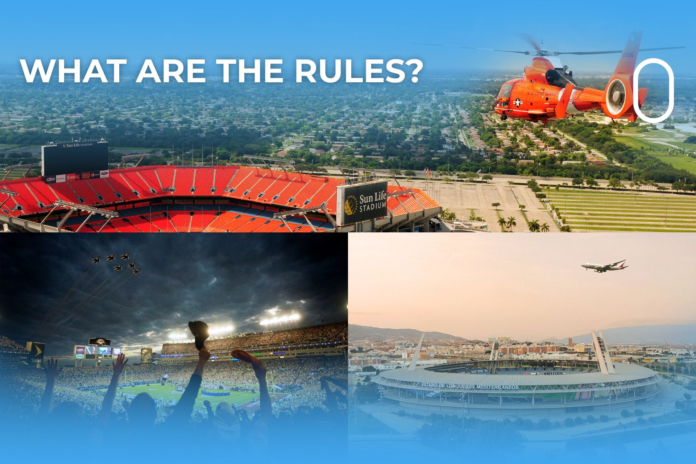Before we look at why you cannot fly planes, helicopters, and drones over or near major sporting events, let’s first define prohibitive airspace. Prohibitive airspace is an area within which aircraft cannot fly. Generally speaking, prohibitive airspace is any area associated with the military, government, and places considered essential for national welfare.
While some areas have permanently restricted airspace, others do not like sports stadiums and presidential retreats like Camp David in Maryland. Aircraft can fly over Camp David if the president is not there. Likewise, you can fly over stadiums if a sporting event is not happening.
SIMPLEFLYING VIDEO OF THE DAY SCROLL TO CONTINUE WITH CONTENT
Black Sunday
You may remember the 1977 action film Black Sunday in which a group of terrorists wanted to hijack the Goodyear blimp. As the blimp was always a feature at significant sporting events, the plan was to seize it and fill it with explosives. Once this was achieved, they would fly it over the Miami Orange Bowl during Super Bowl X. When hovering over the field at a low height, they would detonate the explosives killing thousands of people. If you want to know what happened, you must see the movie or read the Thomas Harris novel.
Want answers to more key questions in aviation? Check out the rest of our guides here.
Drones have become a big problem
Forgetting about areas of strategic importance or planes where the president might be, flights are not permitted over stadiums to stop people illegally filming. High ticket prices and the fact that many big games sell out have, in recent years, made people come up with intuitive ways to watch sports without having to pay. The popularity of drones in recent years has even forced aviation bodies like the UK’s Civil Aviation Authority (CAA) to implement rules for drone use which include:
Flying a drone no higher than 400 feet above the ground.
Never fly a drone within 160 feet of another person unless they are with you.
Never fly over crowds of people.
Stay 400 feet from residential, recreational, or industrial sites.
Never fly a drone within a five-mile radius of an airfield or airport.
Always keep the drone in your direct line of sight.
Drones and aerial banners have been used to deliver political messages and fans’ displeasure about a club’s owners. In October 2014, during a Euro 2016 qualifier between Serbia and Albania at Partizan Stadium in Belgrade, Serbia, an Albania supporter flew a drone over the pitch carrying a Greater Albanian flag.
Ethnic Albanians now live in Serbia, Montenegro, Macedonia, and Greece. The flag symbolizes Albania taking back the land it lost. If you look at the problems in Kosovo, you will realize how this could inflame tensions. One of the Serbian players grabbed the flag from the drone, and a fight broke out, leading to the match being abandoned.
The FAA issues TFRs for sporting events
In the USA, flying banner planes near significant sporting events was commonplace and still takes place under specific guidelines. The Federal Aviation Authority (FAA) issues Temporary Flight Restrictions (TFRs) for important sporting events. These are communicated to pilots via NOTAMs. TFRs are enforced one hour before the sporting event’s start, and executed for an hour after the event is over.
Regarding drones, they cannot be flown within three miles of a stadium with a seating capacity of more than 30,000 when an event occurs.


